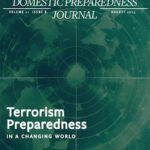People, communities, businesses, and governments around the world are already experiencing the devastating human, economic, and environmental consequences of a changing climate. Many have been impacted by “acute climate shocks” such as wildfires, hurricanes, floods, heatwaves, and severe winter storms – resulting in the loss of lives, livelihoods, and infrastructure. These five steps can help emergency managers build a path to enhance their climate resilience.
In 2017, 16 climate and extreme weather-related disasters had losses exceeding $1 billion, associated with a combined total of 362 deaths across the United States. This compares to the annual average of $5.5 billion weather and climate disasters between 1980 and 2016. More notable than the high frequency of these events is the cumulative cost, which exceeded $300 billion in 2017 – a new U.S. annual record. That shatters the previous U.S. annual record cost of $214.8 billion in 2005 associated with the impacts of Hurricanes Dennis, Katrina, Rita, and Wilma.
People and communities are now faced with more extreme and frequent climate shocks and, when combined with “chronic climate stressors” – such as increased temperatures, declining snow cover, changing precipitation patterns, increasingly frequent and/or intense drought incidence, and rising sea levels – result in “climate hazards.” As climate hazards become more prevalent and impactful, they must be integrated comprehensively into hazard mitigation plans and exercises (facilitated simulations or scenarios of a plausible future). To improve outcomes during and after disasters, emergency managers should incorporate climate hazards (both the acute shocks and chronic stressors) as they engage in the “continuous cycle of planning, organizing, training, equipping, exercising, evaluating, and taking corrective action in an effort to ensure effective coordination during incident response,” as described on the U.S. Department of Homeland Security’s website.
A key challenge in integrating climate change into hazard mitigation or resilience planning is that many other priority hazards exist, including earthquakes, disease outbreaks, cyberattacks, and more. However, if left unmanaged, climate change would significantly exacerbate these other hazards, creating unprecedented challenges by multiplying the threats. For example, a heatwave could stress the already outdated and aging energy grid to the point of failure, which could:
- Leave the grid vulnerable to a cyberattack;
- Result in a complete shutdown of energy utility operations;
- Leave many without power during the heatwave;
- Provide unauthorized access to the personal and financial records of millions of customers; and
- Endanger the health and financial safety of U.S. citizens.
Turning this challenge into an opportunity to successfully execute an all hazards approach must incorporate climate hazards into exercise scenarios. This integrated scenario planning helps planners proactively understand the cascading effects of these combined hazards and allows them to take a systems approach to solutions instead of isolating the hazards from the start. The goal is to collaboratively and comprehensively analyze, design, and exercise future scenarios that allow emergency managers to assess their capacity, prioritize and plan for hazards, protect their assets, and ultimately thrive in the face of a changing climate.
Exercising and Preparing for Climate Hazards Through Resilience Planning
It can be difficult to know where to start when incorporating climate hazards into emergency management and hazard mitigation planning. The steps below, compiled through years of lessons learned, outline how emergency managers can get started on the path to successful climate resilience.
Step 1: Establish a Team
Effective climate hazard preparedness and resilience involves a team – an inclusive yet nimble team – consisting of people who are responsible for protecting critical assets (built, natural, and social) from a variety of hazards to enhance overall resilience. The purpose of the team is to collectively identify and address climate hazards that the organization, community, or region is facing.
When forming a team, be sure to include members within the whole community, as they have valuable insight into historical and current hazards, and are often the first responders when events occur. Consider individuals and groups such as the local departments of health and human services, employment and economic development, housing, emergency management, environmental health, parks and recreation, water and wastewater, or public works along with planning commissioners, boards of supervisors, environmental justice representatives, urban and transportation planners, faith-based organizations, climate scientists or research centers (these tend to be housed within universities), and commercial organizations.
Including groups from many perspectives also brings together many types of resources. For example, faith-based groups can provide a variety of resources from physical shelters to emotional and/or psychological safe houses for those affected by climate hazards. Commercial establishments can do the same. For example, during Hurricane Sandy, IKEA™ offered one of its Brooklyn stores as shelter, which was not only helpful for the community, it was smart marketing for the company – a proverbial win-win.
Step 2: Explore Climate Hazards and Cascading Effects
With a team in place, begin exploring the various climate hazards that the community has faced in the past, and future hazards they are likely to face based on climate models available at the regional or local scale. Many communities have conducted a Threat and Hazard Identification and Risk Assessment (THIRA), a process developed by the Federal Emergency Management Agency (FEMA) that helps communities map their specific risks to core capabilities and is required to be eligible for FEMA funding. Reviewing the latest THIRA is a good place to start, as it provides the team with an understanding of the community’s existing hazards (including climate changes).
Once climate hazards have been identified, the cascading effects (both the risks and opportunities) on the various systems, services, and assets upon which the community depends can then be mapped to connect the dots between the climate hazards and their impacts on the whole community. For example, consider climate hazards related to water and their impact on water utilities and surrounding communities. Water utilities provide drinking water to homes, workplaces, schools, hospitals, and public buildings. Unless these utilities actively exercise potential scenarios that identify weaknesses in their systems, they can be exposed to multiple threats, creating devastating impacts on their customers, infrastructure, and overall reputation.
As the team considers various climate hazards and their cascading effects on the community, the emphasis should also be on understanding how these interact with or exacerbate non-climate hazards that the community has identified (e.g., cybersecurity attacks, disease outbreaks, health crises, and aging infrastructure).
Step 3: Investigate Options and Prioritize Actions
Once the team has identified the current and future hazards and their cascading effects, the next step is to understand the community’s capacity to manage them. Benchmark what has already been done within the community to prepare for, adapt to, and enhance resilience to climate hazards, and then consider what may need to be added to accommodate the cascading effects identified in Step 2. A local government, business, or university may already have conducted a climate hazards assessment and developed a Climate Action Plan that incorporates adaptation or resilience actions. Build off what has already been done; it is critical to leverage existing efforts.
Part of benchmarking should include exercising. Be sure the team is role-playing, acting out true-to-life scenarios, and exercising beyond their abilities. If the team exercises only to capacity, they do not learn their limits. Exercising beyond their limits helps them better understand where improvements should be made.
Step 4: Plan for and Operationalize the Hazards
This step is the culmination of all previous steps. In this step, the team incorporates climate hazards, cascading effects, and associated actions to address the hazards into a new climate resilience plan, or existing plans, that help address future hazards the community faces. Ideally, the team would incorporate climate resilience into broader emergency management or continuity of operations plans, creating strategies that are co-beneficial. It is worth noting that some states and/or jurisdictions may require a separate document, particularly for funding or grant money.
Regardless, the plan(s) should include a broad array of actions that address multiple hazards that have been identified in Step 2. It should define who plays what role, particularly in cross-functional/multidiscipline inclusive plans, including actions that not only enhance resilience to current and future climate hazards but actions that also support sustainability. Many actions that enhance climate resilience are also beneficial for sustainability, such as diversifying energy resources.
Step 5: Act & Continually Improve
Finally, take lessons learned – through exercising or information gathering – and incorporate them into an updated plan regularly. Frequently monitor and evaluate the effectiveness of the plan and update it accordingly. Plans should be updated annually, biennially, or as frequently as required for associated funding. However, they should not go more than two years without updating, given the rapid changes in hazards that may be occurring (e.g., more intense wildfires and mudslides than previously experienced) and the capacity of the team and community to manage these changes. If there are additional funds to invest, be sure to invest them where they would be most effective.
Lastly, think about the future of the local community: what values and assets this community provides; its resilience to climate change; and the ability of its residents to thrive in the face of changing conditions. If there are doubts about the community’s future under a business-as-usual approach, it is time to prepare for and address climate hazards. By creating more resilient communities, their people, assets, and legacies can prevail.

Emily Wasley
Emily Wasley has more than 13 years of experience working with a variety of private, nonprofit, academic, and government organizations on domestic and international climate change research, policy, and strategy. She serves as director of Cadmus’ Climate Security, Adaptation, and Resilience Practice. Prior to Cadmus, she served as the Inform Decisions and Adaptation Science Program manager for the U.S. Global Change Research Program (overseen by the White House Office of Science and Technology Policy), as well as a science translator for federal agencies developing their agency adaptation plans, as a technical climate expert supporting the former Administration’s preparedness pilots, and contributing author of the Third National Climate Assessment’s Adaptation Chapter. She is a certified Change Management Advanced Practitioner (CMAP) and Decision Making for Climate Change professional. She holds an M.A. in Environmental and Natural Resources Policy and a B.A. in Public Policy and Environmental Studies. She also serves as an adjunct fellow for the American Security Project and a member of the U.S. Green Building Council’s LEED Resilience Working Group.
- Emily Wasleyhttps://domesticpreparedness.com/author/emily-wasley





